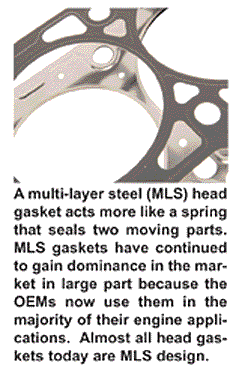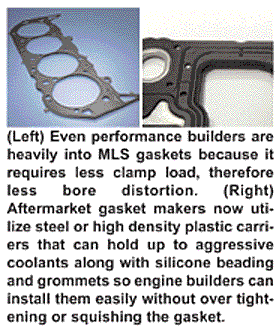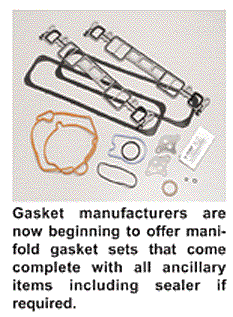With engines now lasting as long as 150,000-plus miles, there’s little doubt that the OEMs have created a monster! Gasket technology advances have played a significant part in the longevity and durability of today’s engines. They must be robust and durable enough to withstand a hostile environment for such a long life, and without leading to gasket failure.
A gasket needs to keep things, such as engine oil, coolant, vacuum and combustion, properly separated within an engine: to achieve this, gasket engineers have tried various materials to seal the engine. Nowadays, your customers demand the OE equivalent from your rebuilt engine, so you need gaskets that are up to the task.
A robust gasket design is one that will hold up for the life of the engine under less than ideal operating conditions. Clamp loads may vary, fatigue and gasket creep may set in, a flange may warp or distort, but the gasket must continue to do the job despite such circumstances. To counteract these issues, gasket makers have employed a healthy dose of ingenuity and high-tech materials to help you keep your engines in service and free of leaks.

We interviewed several gasket makers to discuss the latest trends in gasket design and materials. One common acknowledgement from our interviews is, in fact, that gasket development in the aftermarket is the result of new OEM designs. As new engines become lighter and more fuel efficient, sealing them can become a greater challenge. For the most part, aftermarket gasket makers follow along the same lines as the OEM design, but there are instances, especially where the original design may have been flawed to begin with, where aftermarket gasket manufacturers decide to take a different approach.
Head gaskets have several functions. The primary function of a head gasket is, of course, to seal compression. If it doesn’t seal compression the engine doesn’t run very well. The second thing it has to do is seal fluids. It needs to keep the coolant in the water jackets and oil in the galleries (in many cases it has to seal high pressure oil for OHC engines) and compression in the compression chamber, etc.
If the engine was static and never ran it wouldn’t be difficult to seal the joint. But in reality, what happens every time a cylinder fires, pressure in that cylinder (1,200 – 1,800 psi of cylinder pressure) lifts the head up slightly off the engine. In turn, that relaxes the load on the gasket. As soon as that cylinder is fired and the load is gone it clamps back down on the engine.
You’ll often hear gasket guys always talk about how the head gasket acts more like a spring than a flat object – that’s because it’s essentially giving and relaxing and compressing, thousands of times as the cylinders fire. Despite the movement, everything is fine, usually – unless there’s more pressure than there is spring available in the gasket.
When engines start making more power, as is common in performance applications, you have more liftoff on the head and loss of load on the gasket. Therefore, gasket makers have to determine how much load the gasket can handle, how thick does the center need to be, should extra beading be used around the combustion chamber to increase the load? All those issues start to crop up as you move away from stock replacement applications, say gasket experts.
Not that long ago, gasket makers worried a lot about detonation and pre-ignition destroying head gaskets, but today that’s not as much of a worry. In most cases these days you don’t have many detonation/pre-ignition issues on modern engines because of the electronic engine controls and the fact that every electronic engine uses a knock sensor, which retards the timing if it detects anything. A performance or stock application where engines don’t use a knock sensor, though, could conceivably start getting into these issues again, according to experts.
The head and block joint is the most difficult to seal on an engine, and therefore gets a lot of attention from gasket makers in research and design. Part of the OEM attraction to multi-layer steel is that it doesn’t compress and stay compressed like a composite gasket. An MLS gasket acts more like a spring that seals two moving parts. Manufacturers say that MLS gaskets have continued to gain dominance in the market in large part because the OEMs now use them in the majority of their engine applications. Almost all head gaskets today are MLS design, say experts.

With the exception of GM, OEMs began using MLS head gaskets on new engine platforms beginning in the late ’80s and transitioning through the mid- ’90s.
GM is about a decade behind the rest of the industry with respect to the MLS trend, according to industry experts. During a time when other manufacturers were going to bi-metal engines and MLS, GM made a conscious decision to stick with heavier weight, heavier casting engines. While GM did begin the transition to MLS in the late ’90s the General is still undergoing that process today.
GM introduced the Northstar engine in the mid-’90s when everyone else was going with MLS, however it featured a composite gasket. GM changed to MLS in some truck applications that were originally graphite composite head gaskets.
At the same time, some OEMs switched to an MLS gasket even though they didn’t upgrade their engines. The GM 4.8L, 5.3L and 6.0L are good examples. One gasket manufacturer says their research revealed that GM didn’t change any castings or torque specs on these engines, or that there was any increased movement, GM simply made the decision to use the MLS gasket. However, in most cases when the OE designs a completely new engine, the motion between the head and the block is such that it demands the MLS for it to seal.
While the main reason for the switch to MLS was to accommodate a greater amount of movement, some experts point out that there are cases where a graphite gaskets work fine, and OEMs may not have made any other major engine design changes besides switching to MLS just for the sake of technology.
In their existing older engine applications the OEs continued using composite gaskets. For example, when DaimlerChrysler replaced the 2.2L and 2.5L platform with the Neon 2.0L and 2.4L platform, they switched to a MLS gasket with the new engine design, while the Jeep 4.0L has been around for decades with the same composite gaskets.
So for all of the moves to MLS there are still plenty of old engines still in production. The 3.0L Taurus engine is another example; it still uses a composite gasket that Ford has never upgraded.
While multi-layer steel head gaskets have been the industry standard on the OEM side for a long time, there hasn’t been anything else in the works that is a better replacement either. Certainly gasket manufacturers have been kicking around concepts as to what is going to be the next thing to replace MLS. However, nothing has panned out at this point.
The biggest development from the OEMs, say experts, has been the reduction of the number of layers in an MLS gasket as much as possible, while still accomplishing the same performance. The OEs have accomplished a more efficient design in some cases as a result of the advances in technology. So experts say the trend will be more two and three layer gaskets instead of fours and fives, but not necessarily across the board.

Materials and Designs
With regard to materials and designs, aftermarket gasket manufacturers have continued to make steady improvements in bead designs, stopper designs and coatings where possible. Experts say even though there haven’t been major design changes, fine-tuning has allowed the aftermarket manufacturers to continually improve products avaiable to rebuilders.
Experts say head lift can be controlled by balancing combustion pressure with the right amount of clamp load from the head bolt. The deflection of the cylinder head itself has to do with the spacing of the bolt, the rigidity of the casting, the coolant passages and so on. One gasket manufacturer says it has a fixture to measure cylinder head liftoff and deflection on individual applications. When this gasket maker was developing MLS gaskets for older Ford engines, it discovered a great amount of head lift. In essence, the more head lift you have, the more layers you need to seal the joint.
Since it’s made of spring steel as compared to mild steel or copper, the spring effect of MLS is the main advantage over regular composition gaskets. If you were to emboss copper, for instance, and put a load on and take it off repeatedly, it’s going to stay compressed. But with a full-hard stainless steel embossment, it’s going to spring back more easily, say experts. So as the cylinder head and block move around, the gasket is going to follow that movement a lot better.
Coatings have changed quite a bit with the development of MLS aftermarket gaskets, according to experts. The best way to explain that is the difference in aftermarket machining and installation procedures. On the OE-level you have a new head, block, bolt and a very precise surface finishes, very precise installation methods. In the aftermarket you run the gamut from some shops that can follow all the OE-level procedures all the way down to those that can’t achieve any of the surface finish requirements. However, experts say that from what they have seen in recent years, engine builders are stepping up to the challenge with better equipment and techniques to handle more precise requirements.
Head-Bolts
One of the other benefits or reasons OEMs like to use MLS gaskets is so they can reduce the amount of head torque that is required, say gasket experts. When you reduce the amount of clamp load your head movement will go up a little but the benefit, especially with lightweight castings, is a reduced amount of head bolt torque that will in turn reduce the amount of bore distortion. That’s very important to the OEs, say experts, because obviously, the rounder the bore is, the better ring seal and better emissions level result. This is a big reason OEs use the MLS along with the lighter weight castings.
But it’s not just the case at the “boring” OE level…several NASCAR teams have discovered this as well: by reducing the amount of torque you have less bore distortion, which produces a little more horsepower. For NASCAR teams a little horsepower is a lot.
Experts say that OEs are starting to move away from torque to yield (TTY) bolts to a more reliable torque to angle (TTA) head bolt. With TTY, when you tighten the bolt, it is stretched to just below the breaking point of the bolt (yield). With TTA the bolt is still stretched, but to a lower limit. So the TTA bolts are less stressed than the TTY bolts. Most people refer to all head bolts as TTY but technically the initial trend was to stretch to just before failure point.
Nowadays, many manufacturers aren’t going that far because of the obvious risks. The bolts are still designed the same (longer and skinnier in the middle) and it may only take a quarter turn to get the bolt up to the proper angle, which sets the desired clamp load.
With TTA and TTY bolts, friction is taken out of the equation. Threads that are not uniform or cleaned, or have not enough or too much lubrication may cause frictional differences in the bolt torque resulting in uneven, inconsistent clamp load.
Ancillary Gaskets
There has been a move from what just four or five years ago would have been a paper gasket with a silkscreen bead on it, into an embossed single layer steel gasket for sealing many other applications such as intake manifolds and valvecovers. These gaskets typically have a little raised bead that is die stamped in steel and embossed.
Gasket experts say the new steel carrier gaskets appear to seal better and be easier to install correctly. A major aftermarket gasket manufacturer says it is making these changes to follow along with the OEMs. Engine builders and technicians don’t really want something radically different than what was original found on the engine. If a guy tears down a ’98 Dodge and he pulls the intake plenum off to find a little steel shim in there, that’s what he wants to put back in. In studies, gasket makers have found that engine builders don’t typically want to see paper or silkscreen or something other than the OE design in many stock replacement cases. It’s always been an issue to match the OEMs but it seems even more prevalent today. And aftermarket manufacturers really try to keep up with what the OEMs have and follow the same lines.
Often times it’s a running change, too. For example, a 1995-’97 application may have used a paper shim but in ’98, because the OEM realized that there was an issue that need to be corrected began using steel. Gasket makers say when they see the changes they’ll make the change for the aftermarket as well.
When designing any gasket, manufacturers say they look at the aftermarket repair environment, which in many cases can be very different from OE production environments. One gasket manufacturer says it tries to accommodating the various nuances in the industry any time a new gasket is designed. In some cases OE gaskets and aftermarket gaskets are the same thing, however, often times there are slight differences in coating materials, gasket thickness, and other elements that will fit the rebuilding environment better.
One aftermarket solution that has been around for a while is the development of intake manifold gaskets that are designed to be more resistant to aggressive coolants. The older ethylene glycol coolants are less aggressive than the newer Dex Cool coolants, which deteriorates the carrier.
However, the OEMs have come up with a revised gasket that uses plastic and rubber around the coolant ports to keep coolant from attacking the plastic which can be a problem with extended life coolants.
For intake manifold gaskets, aftermarket manufacturers offer some premium products and say they will continue to come up with products that address issues in the industry.
Many of the OEMs have shifted to a solid carrier design for pan gaskets and valve covers. And some designs feature a groove where the gasket presses in for easier locating. So there’s a little more of trend now toward a groove actually being machined into the block for the press and place gasket.
Valve cover gaskets are pretty similar to oil pan technology. Some OEs use a press in place gasket for valve covers but that hasn’t become the prevailing trend yet, say experts. There are some applications like a Ford V10 that uses an integrated bead right in the cover. And this trend has been seen on the aftermarket side as well, where you can then scrape off the bead and replace it instead of having to buy a new OE cover. That’s been one of the sticking points with some of these designs, according to experts, because when customers would go to replace the gasket they essentially had to buy a new cover.
Aftermarket manufacturers are now designing separate gaskets as a replacement for some of these applications, but experts say this is a trend that may have come and gone as many of the OEs are going back to separate gaskets also.
Oil Seals
Oil seal manufacturers have been using high performance materials such as silicone and Viton for years. However, now one manufacturer has begun using PTFE, also known as Teflon. Essentially it’s a seal that’s very appropriate for high heat and is resistant to abrasion, say experts. It does a really good job of keeping contaminants out of the crankcase, especially in manual transmission applications where there’s a lot of clutch dust.
One thing to keep in mind with these seals, cautions one expert, is that they need to be installed dry, which is the opposite of everything you’ve ever heard. So the manufacturer includes an information sheet that explains how to install correctly. And once it’s installed, it will maintain a seal almost indefinitely.
Special thanks to the folks at Federal-Mogul, Clevite Engine Parts and Rol Manufacturing for photos and information. For a more complete list of gasket suppliers click on the Buyers Guide from our home page.













